If there’s one dish that is quintessential during the fasting or vrat season in the Indian subcontinent, it has to be Sabudana Khichdi. Made with sago pearls or sabudana, boiled potatoes, roasted peanuts and a few spices, Sabudana Khichdi Recipe is most popular during the fasting days of Hindu festivals like Navratri, Mahashivratri and Ekadashi. Many people have many ways of making it. However, here, I have shared many to-dos for the most perfect, non-sticky Maharashtrian style khichdi made with sabudana. This is the recipe I have been making for decades.

Why You’ll Love This Sabudana Khichdi
This Sabudana Khichdi recipe is an easy and delicious snack that can be made during your vrats or fasting days. However, it does require some skill and experience to make this khichdi, in which the sabudana pearls are not sticking or have turned into a lumpy mass.
Sabudana is the Hindi term for ‘sago’ or ‘tapioca pearls,’ and are made from the roots of the cassava plant. Another name of this plant is tapioca or yuca.
Since it is naturally a plant-based foodstuff and is gluten free as well, it is a great vegan alternative as well as a tasty substitute for wheat-based flours too. Another sago favorite of mine is this Sabudana Vada.
When you make Sabudana Khichdi, you have to adjust the soaking time as per the type of tapioca or sago pearls. For some varieties, 2 to 3 hours is fine and for some you may need to soak for more than 3 hours or overnight. So, do soak the sabudana pearls accordingly.
Table of Contents
For soaking, just cover the sago pearls with water for some time and you are done. I have mentioned in the steps below, on how to test the soaked sabudana pearls that are perfect to be used in the recipe.
Also, in this Sabudana Khichdi Recipe, I have demonstrated the step-by-step version of soaking the sago pearls overnight. However, you are free to adapt the soaking time as per the quality of tapioca pearls you have.
This Sabudana Khichdi is not just a yummy dish that I have grown up having, umpteen times. It is loaded with carbohydrates and the proteins coming only from peanuts. Sabudana is rich in carbs, and hence this dish makes for a filling snack.
How to make Sabudana Khichdi
Soak Sabudana
1. Rinse 1 cup sabudana, sago or tapioca pearls a couple of times in running water until all the starch is washed away. You can use a colander while rinsing.
Soak sabudana in water. The water level can be 1.5 to 2 inches above the sabudana.
In the picture below, sabudana pearls are already soaked. Depending on the quality of sabudana, you can soak them overnight or for some hours.
I always soak them overnight, since even after soaking them for 2 to 3 hours, they don’t soften.
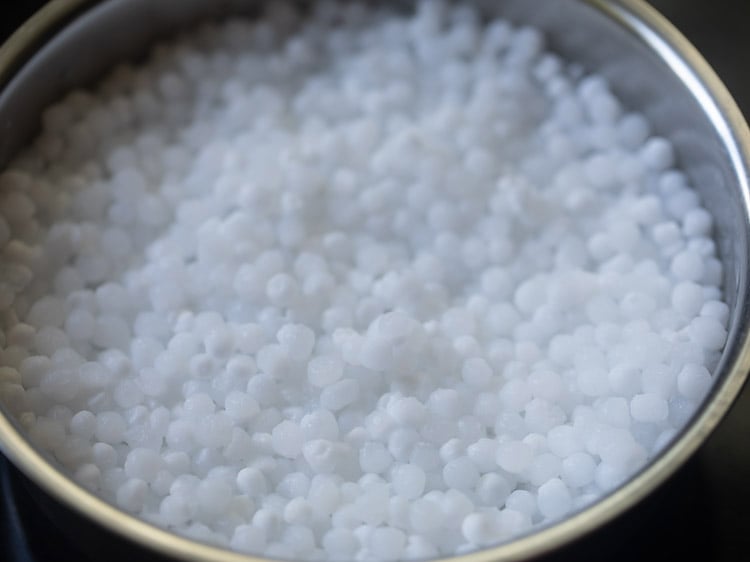
2. To check if sabudana has become soft or not, you should be able to easily press the sabudana and it should get mashed easily.
If there is some hardness in the center of the sago pearls, then add a few tablespoons of water in the bowl. Cover and leave for 30 minutes more.
Note that the pearls have to be softened thoroughly. If the center is hard, the khichdi will not have a good texture as sabudana will not cook well.

3. Using a strainer or colander, strain all the water from sabudana. Strain very well as there should be no extra water in the sabudana. Keep aside.
Remember to drain the water really very well. Any water logged in the sago pearls will make your khichdi mushy or pasty.
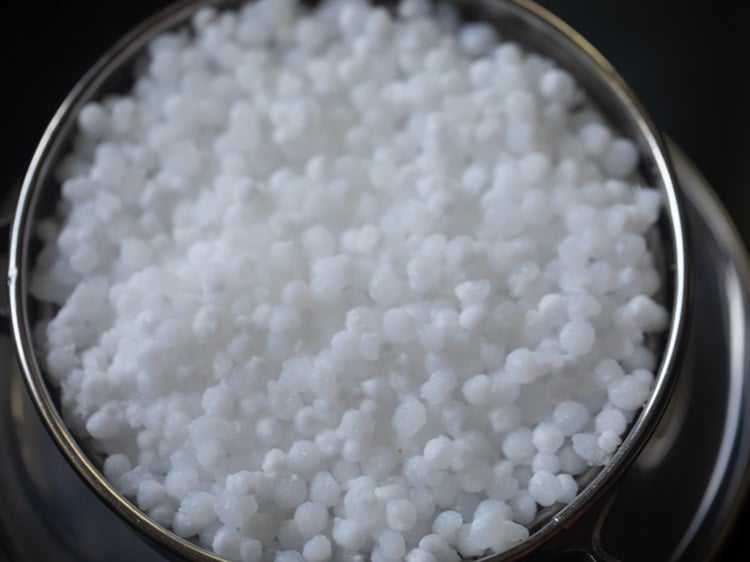
Cook Potatoes
4. While sabudana is getting soaked, you can boil 2 medium-sized potatoes in a pan or in a cooker and keep aside.
For pressure cooking, just add enough water covering the potatoes and then pressure cook on medium heat for 4 to 5 whistles.
You can also steam the potatoes in an Instant Pot, adding required amount of water.

5. When the pressure settles down naturally in the cooker, then only open the lid. Remove the potatoes and let them become warm or cool completely. Then, peel and chop them.
Instead of boiling potatoes, you can even shallow fry potatoes and then add them to the khichdi.

Make Peanut Powder
6. Heat a kadai (wok) or a frying pan. Add ½ cup peanuts (moongphali).

7. Keep heat to medium-low and stirring often, roast the peanuts.

8. Roast till the peanuts become crunchy. You will see the peanut skins getting browned or charred.
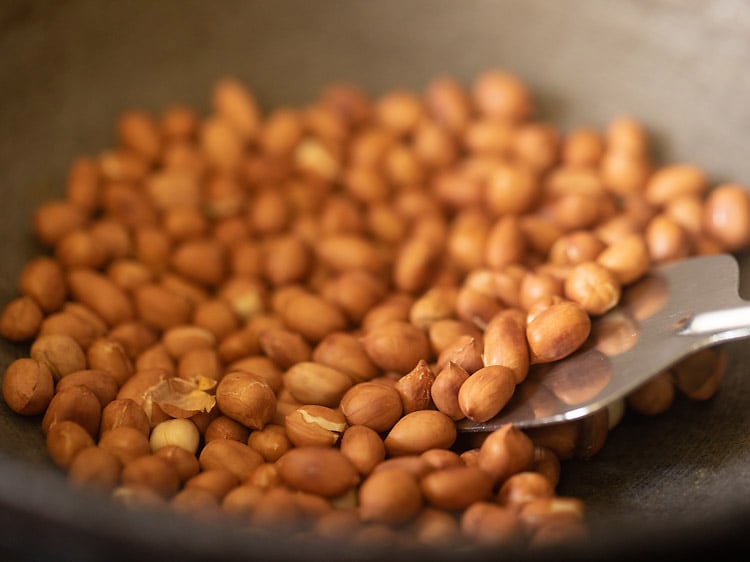
9. Turn off the heat and keep the peanuts aside to cool. You can remove the peanut skins, if you want.

10. Add the cooled roasted peanuts in a small grinder jar or blender.
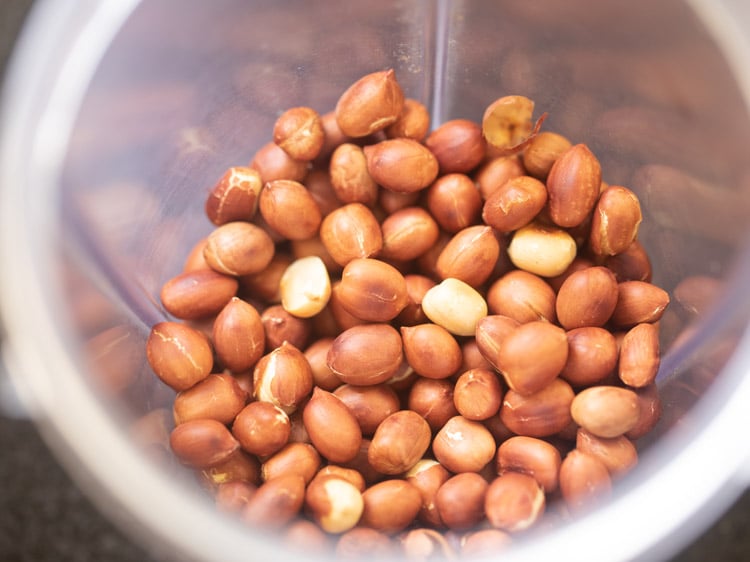
11. Using the pulse option, powder the peanuts coarsely. Do not grind at a stretch, as then the peanuts will release their fat.
Grind in parts and for a few seconds as we just need to make a coarse or semi-fine peanut powder. You can even coarsely powder the peanuts in a mortar-pestle.
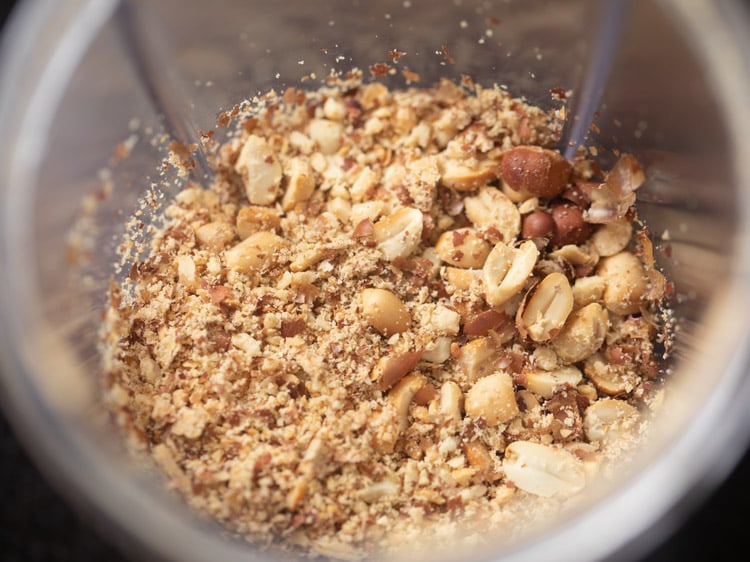
12. Take the well drained and soaked sago pearls in a mixing bowl, plate or tray. Then, add the ground peanut powder in to it.
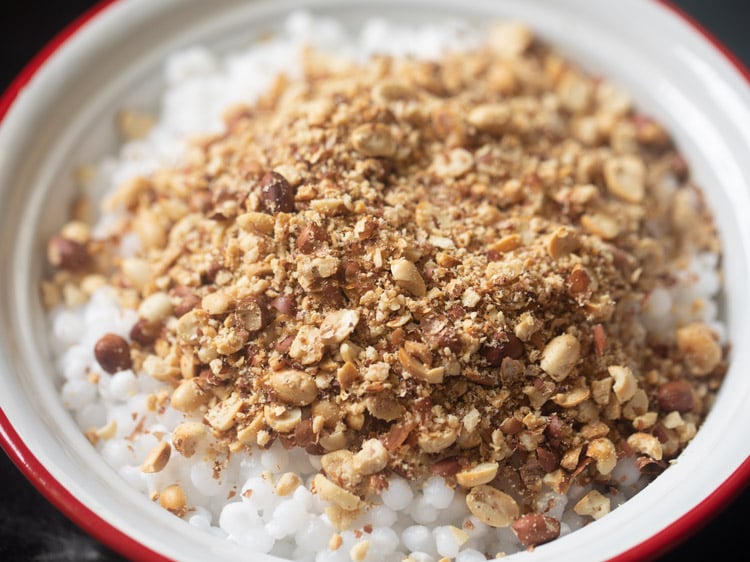
13. Also add edible rock salt (sendha namak) as per taste and ½ to 1 teaspoon sugar.
In the Hindu fasting food, we use rock salt. If making this dish on regular or non-fasting days, then you can swap rock salt with regular salt.
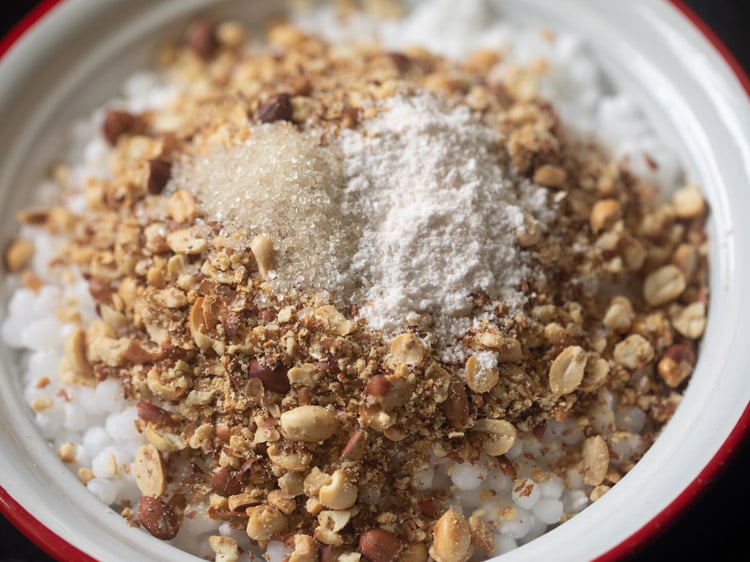
14. Mix very well with a spoon.
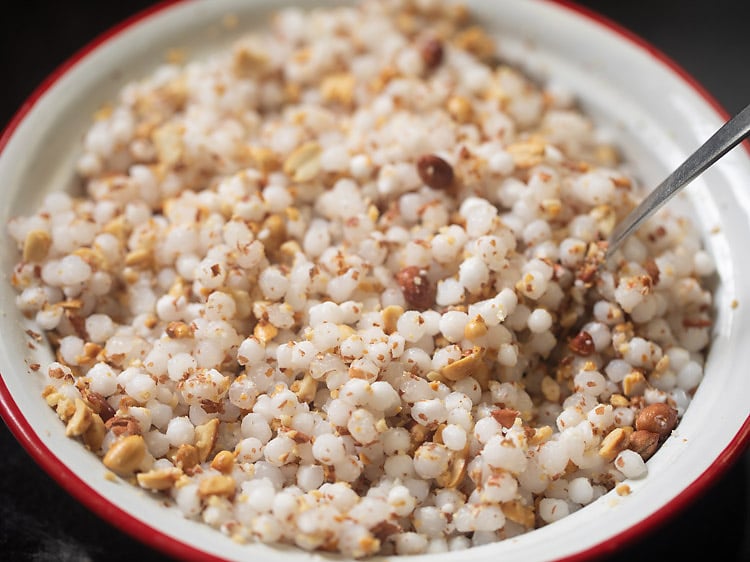
Make Sabudana Khichdi
15. Heat 3 tablespoons peanut oil or ghee (or your preferred oil) in a heavy kadai or pan. Keep the heat to a low or medium-low.

16. Add 1 teaspoon cumin seeds.
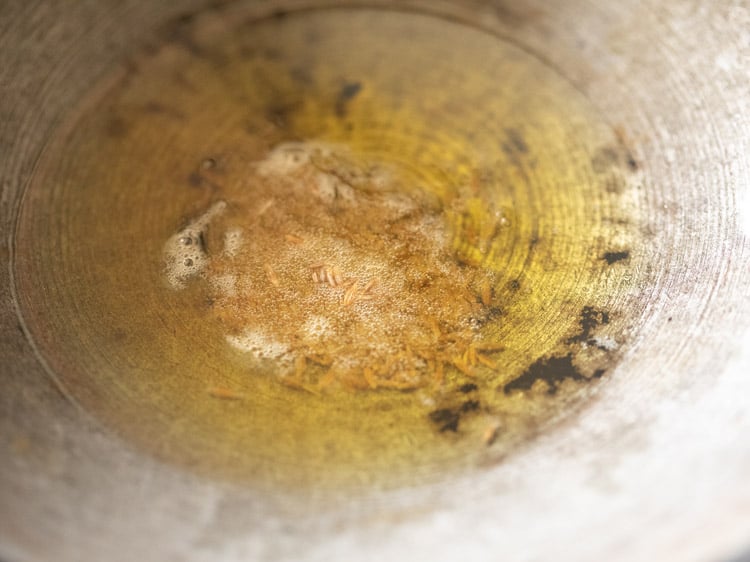
17. Let them crackle and get browned.

18. Then, add 1 chopped green chilli (about ½ to 1 teaspoon, chopped).
I do not add curry leaves to the sabudana khichdi that I make during the fasting or vrat. But accordingly as followed in your family, if curry leaves are allowed as a fasting ingredient, you can choose to add them.
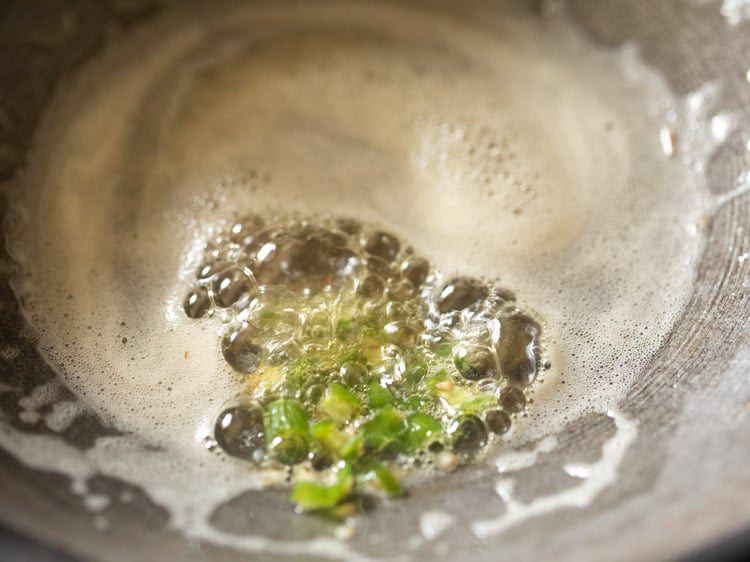
19. Fry on medium-low heat for a few seconds.
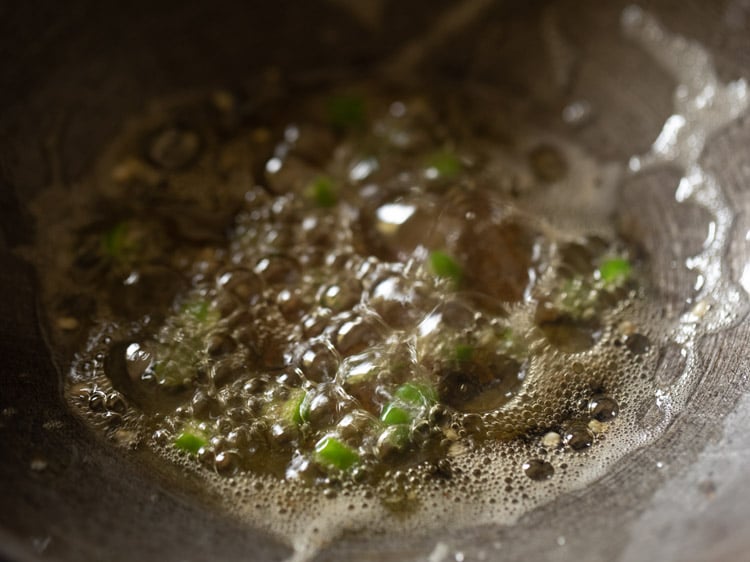
20. Now, add the chopped boiled potatoes.
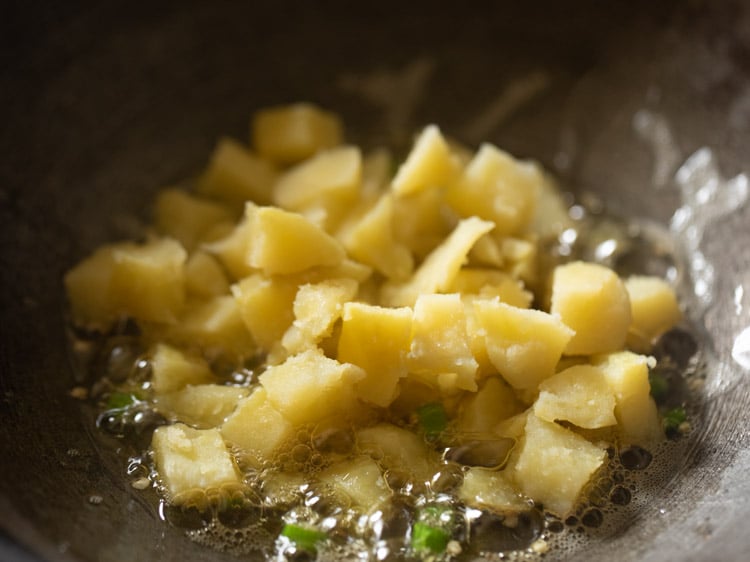
21. Mix and sauté on medium-low heat for a minute.

22. Next, add the sabudana-peanut powder mixture.

23. Mix very well.
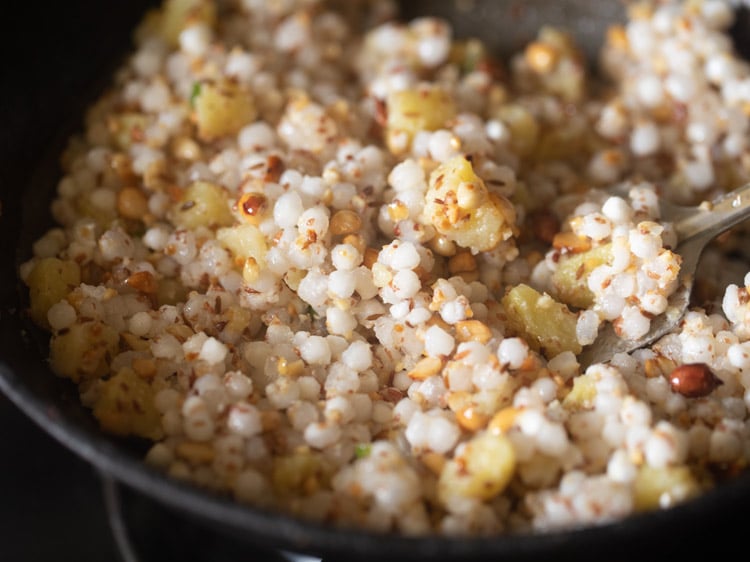
24. Sauté on a low heat, stirring continuously, for about 3 to 5 minutes.
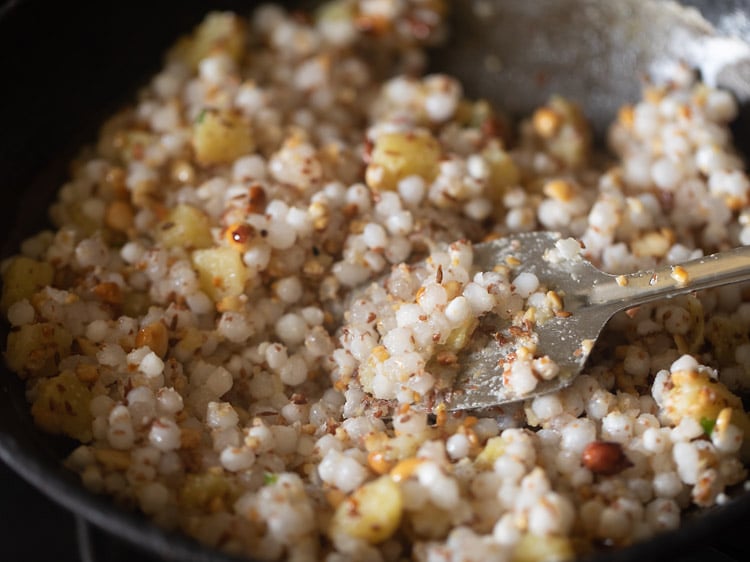
25. Sauté till the sago pearls becomes translucent. Taste a few cooked sabudana pearls. You should not get a raw taste.
Once cooked, turn off the heat. Do not overcook as the sabudana can become lumpy and chewy.
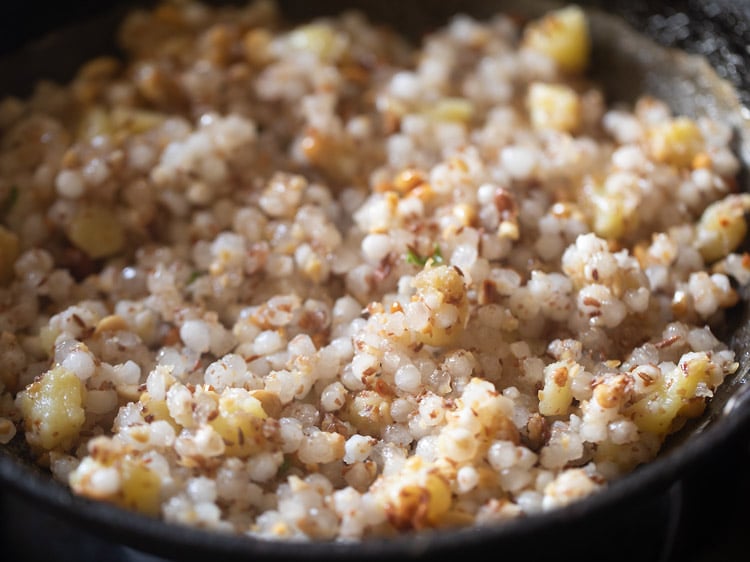
26. Then, add 1 teaspoon lemon juice for some tang.
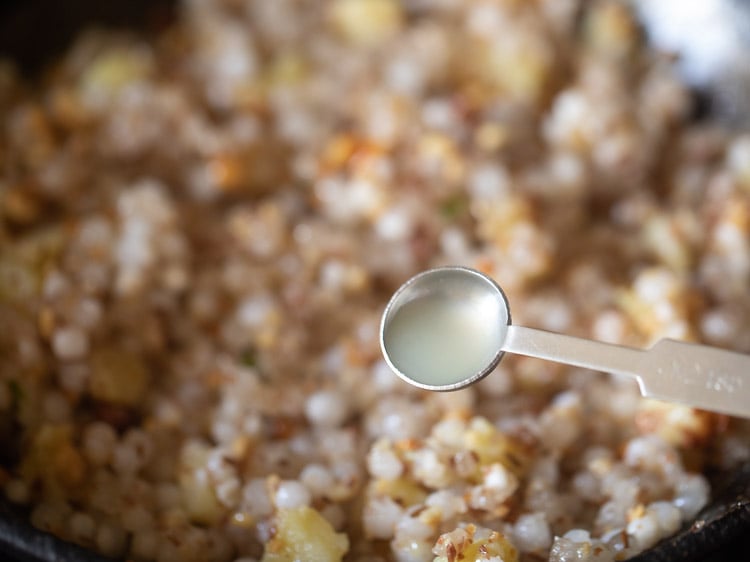
27. Add 1 to 2 tablespoons chopped coriander leaves. If you do not eat coriander leaves during fasting, then you can skip them.

28. Mix well.

29. Serve Sabudana Khichdi hot or warm. While serving, you can also garnish with a few coriander leaves and some grated fresh coconut.
You can eat sago khichdi as is or with a side of sweetened curd (yogurt) or coconut chutney that is specifically made for fasting days.
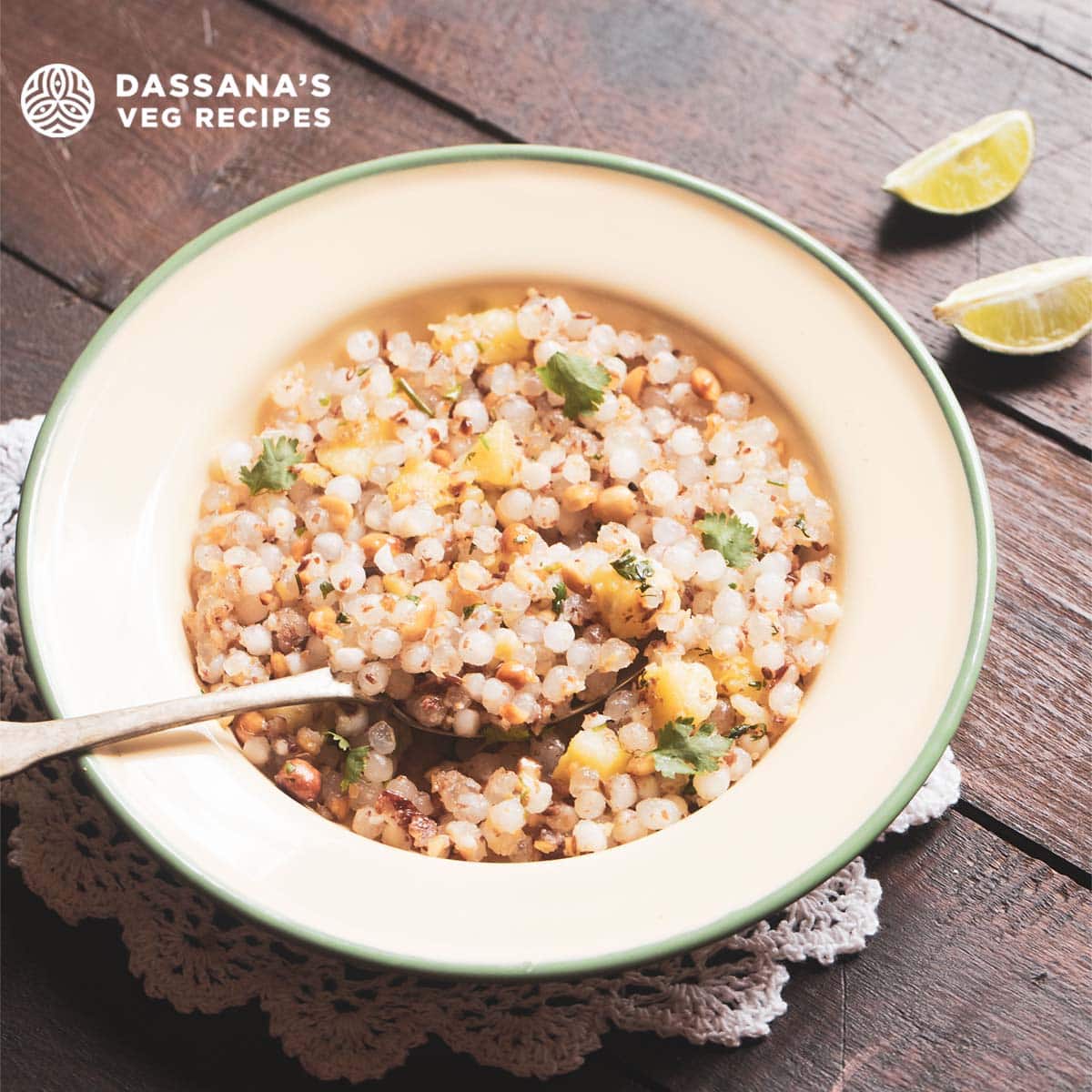
Expert Tips
- Rinsing Sago: Rinse the sabudana pearls in a colander, under running water, very well until you feel that all the starch is rinsed and washed away. This thorough rinsing aids to clear out the excess starch that causes the sabudana khichdi to become lumpy, mushy and sticky.
- Soaking Sago: Transfer the washed and drained sabudana in a bowl. Add water with its level just above 1 to 1.5 inches in the bowl. Cover the bowl and leave the sabudana pearls for 3 to 4 hours or overnight. The time duration will depend on the quality of sabudana pearls.
- Sabudana Quality: Depending on the quality of sabudana, it can take less or more hours for soaking or will require less or more water. Before cooking, check the soaked sabudana. Press a few pearls. They should mash easily.
- Sabudana not soaked well: If you feel some hardness in the center, add few tablespoons water and leave for 30 minutes more. If the sabudana is not soaked properly and the center is hard, it won’t cook well. For a good texture and taste, the soaked sabudana has to be softened well.
- Straining soaked sabudana: Using a colander or sieve, strain the water from the sabudana well. Excess moisture can make the khichdi mushy, sticky, lumpy and pasty.
- Pan Type: Use a well-seasoned, thick bottomed and heavy frying pan or wok to make this dish. A light weight or a non-seasoned pan may lead to the sabudana sticking to the pan and even getting browned.
- Scaling: You can easily halve or double this Sago Khichdi Recipe.
More Tips
- Cooking Potatoes: Potatoes can be boiled, steamed or fried before adding to the khichdi. I always boil them and sometimes I shallow fry them separately. Take care to cook them until fork tender only.
- Fats: You can use peanut oil or ghee to cook this khichdi. Or opt to use the fat of your choice or the one which you usually use to cook your fasting or vrat food.
- Cooking sabudana: Remember not to overcook sabudana, as it can become dry, chewy and dense. It should have a nice softness after being cooked.
- Herbs and Spices: Green chillies and coriander leaves can be skipped. Feel free to include or exclude the spices or herbs that you generally use during the fasting.
- Salt: If making the khichdi for fasting days, add edible rock salt (sendha namak) in the khichdi. For non-fasting days, you can add regular salt.
Variations
In addition to my Sabudana Khichdi Recipe on this post, here’s another variation to make this vrat-friendly dish. This version was shared by one of my readers, Minal.
According to her method, cooking the Sago Khichdi in a frying pan kind of helps in keeping the tapioca pearls dry and separated. Besides, having to use very little oil.
This is how you proceed:
- In a frying pan heat oil, add cumin seeds (jeera) and curry leaves and fry a little. Then, add potatoes cut into small cubes and fry on sim (low heat) till the potatoes cook. Alternately, you can cover with a lid to speed up the cooking.
- In the meantime, mix together soaked and drained sabudana, crushed peanuts or peanut powder, chopped coriander leaves (cilantro), salt, some black pepper powder, red chili powder, chopped green chilies and mix well with your hand. Keep aside.
- Check if the potatoes are cooked. Once done, add the prepared sabudana mixture to the potatoes and mix well.
- Adjust salt, drizzle very little water on the mixture, cover and cook on low heat for 2 minutes.
- Mix well and enjoy sago khichdi.
More Sabudana Recipes To Try!
Navratri & Fasting Recipes
Navratri & Fasting Recipes
Navratri & Fasting Recipes
Sabudana Chivda Recipe | Sabudana Namkeen Recipe | Sabudana Snacks
South Indian Food Recipes
Please be sure to rate the recipe in the recipe card or leave a comment below if you have made it. For more vegetarian inspirations, Sign Up for my emails or follow me on Instagram, Youtube, Facebook, Pinterest or Twitter.

Sabudana Khichdi Recipe
Ingredients
- 1 cup sabudana – sago or tapioca pearls, 150 grams
- water as required, to soak sabudana
- 2 potatoes – medium-sized
- ½ cup peanuts – roasted
- 8 to 10 curry leaves – optional
- 1 teaspoon grated ginger – optional
- 1 green chili – chopped or ½ to 1 teaspoon
- 1 teaspoon cumin seeds
- ¼ cup coconut – grated, fresh – optional
- ½ to 1 teaspoon sugar or as required
- ½ to 1 teaspoon lemon juice (optional) or as required
- 3 tablespoons peanut oil or ghee
- rock salt – edible and food grade, (sendha namak) as required
- 1 to 2 tablespoons coriander leaves – chopped, optional
Instructions
Preparation
- Rinse sabudana very well in water. Then soak sabudana overnight or for 3 to 5 hours.
- After the sabudana has soaked well enough, check if they have become soft or not.
- To do this take a few pearls and press them with your fingers. They should get mashed easily. If you feel some hardness in the center of the sabudana pearls, then add a few tablespoons of water in the bowl. Cover and leave to soak for 30 minutes more.
- Drain the soaked sabudana very well of all the water and set aside.
- Boil the potatoes and when warm peel and chop them.
- In a pan, dry roast the peanuts till browned and when cooled make a coarse powder in a mortar-pestle or in a dry grinder.
- Mix the coarsely powdered peanuts, salt and sugar with the drained sabudana.
Making sabudana khichdi
- Now heat peanut oil or ghee. Fry the cumin first till they crackle and get browned on low to medium-low heat.
- Now add the curry leaves if using and green chillies. Fry for a few seconds and then add the grated ginger if using. Both curry leaves and ginger are optional and can be skipped.
- Saute for a couple of seconds till the raw aroma of the ginger goes away. Now add chopped boiled potatoes and saute for a minute.
- Add the sabudana. Keep on stirring often on a low heat for about 3 to 5 minutes.
- When the sabudana loses their opaqueness and starts becoming translucent they are cooked.
- Don’t overcook as they might become lumpy and hard.
- Turn off the heat and add lemon juice and chopped coriander leaves. Mix well.
- While serving garnish with a few coriander leaves and drizzle with some lemon juice. You can even add some grated fresh coconut on top.
- Serve Sabudana Khichdi hot or warm as is. Or you can serve with a side of sweetened curd or a satvik coconut chutney made with fasting ingredients.
Video
Notes
- Rinse the sabudana pearls very well in water to get rid of excess starch.
- Depending on the quality of sabudana you soak them in less or more water or for less or more time. If the sabudana is not soaked properly and if the center is hard then it won’t cook well. For a good texture and taste in the khichdi, the soaked sabudana has to be softened really well.
- After the sabudana pearls are soaked well, drain all the water very well. If there is any water left then this sago khichdi will become pasty or mushy.
- Potatoes can be boiled, steamed or fried and then added to sabudana khichdi. I generally boil or steam the potatoes and sometimes fry them.
- You can skip green chilies and coriander leaves if you want.
- For Hindu fasting during Ekadashi, Navratri, Mahashivratri, please add edible rock salt (sendha namak) in the sabudana khichdi.
- The recipe can be halved or doubled easily.


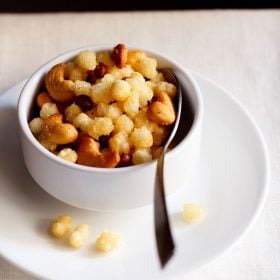
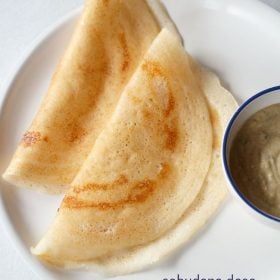



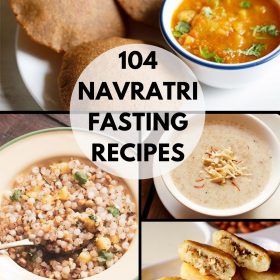








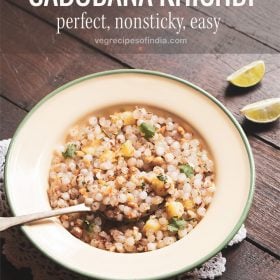
Loved your recipe and tips and the khichdi came out really tasty, thank you.